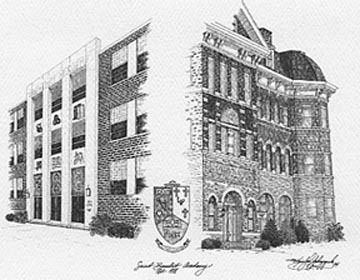In September, 1951, Bishop John Mark Gannon initiated the expansion of the Academy when he asked Mother Sylvester Groner if the Benedictine Sisters would be willing to take on a building project to increase their facilities for the education of high school girls in the city of Erie.

Bishop Gannon presided at the groundbreaking on September 18, 1953, and again at the dedication on December 8, 1955, exactly 85 years from the date of the dedication of the first school building.
The new Saint Benedict Academy opened its first classes in September of 1955 with an enrollment of 459 students representing 19 parishes.
A multi-talented and visionary woman, Sister Theophane Siegel was principal from 1946 to 1958. She was quick to adapt to new situations, prepared for action when necessary, and keenly perceptive of what the future held. Not only did Sister Theophane help design the blueprints for the new Academy, oversee its construction and plan the curriculum, she also infused it with a unique SBA spirit—a school that provided both quality education and a close knit, loving community.
The new Academy housed complete facilities for instruction in college preparation and commercial education. In addition to the regular classrooms, completely equipped science labs, clothing and food labs, art studio, office machines room and type room provided adequate space and means for all students.
Familiar faces are loved faces. For one hundred years many loyal teachers, lovingly concerned and professional—lay and religious alike—devoted their talents to the girls of SBA and consequently, became familiar and loved by the students.
Every Lassie who attended SBA since 1935 knew and loved coach Thomas "Boody" Sullivan. It was Boody, too, who gave the impetus to the Saint Benedict Parent Association, having served as the first President of the original SBA Boosters in 1956.
After meeting the needs of young women for almost 120 years, Saint Benedict Academy closed in 1988.
SBA became Saint Benedict Education Center. Job training programs, high school equivalency degrees and a community of support are offered to the new poor—many who are single mothers—in need of education and resources in order to move into the mainstream of society.
